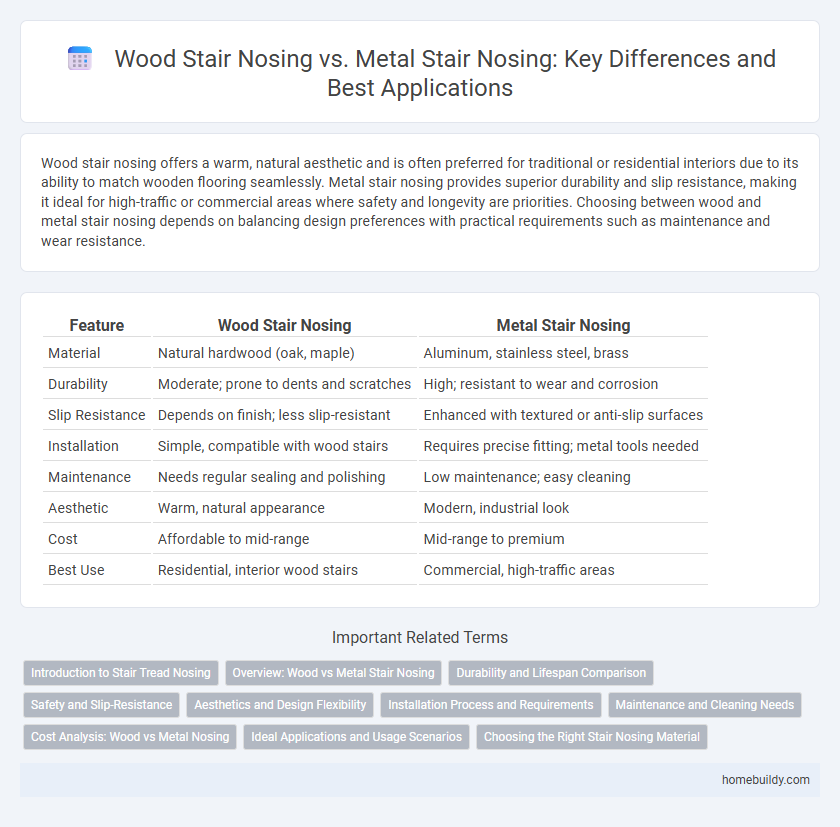Wood stair nosing offers a warm, natural aesthetic and is often preferred for traditional or residential interiors due to its ability to match wooden flooring seamlessly. Metal stair nosing provides superior durability and slip resistance, making it ideal for high-traffic or commercial areas where safety and longevity are priorities. Choosing between wood and metal stair nosing depends on balancing design preferences with practical requirements such as maintenance and wear resistance.
Table of Comparison
| Feature | Wood Stair Nosing | Metal Stair Nosing |
|---|---|---|
| Material | Natural hardwood (oak, maple) | Aluminum, stainless steel, brass |
| Durability | Moderate; prone to dents and scratches | High; resistant to wear and corrosion |
| Slip Resistance | Depends on finish; less slip-resistant | Enhanced with textured or anti-slip surfaces |
| Installation | Simple, compatible with wood stairs | Requires precise fitting; metal tools needed |
| Maintenance | Needs regular sealing and polishing | Low maintenance; easy cleaning |
| Aesthetic | Warm, natural appearance | Modern, industrial look |
| Cost | Affordable to mid-range | Mid-range to premium |
| Best Use | Residential, interior wood stairs | Commercial, high-traffic areas |
Introduction to Stair Tread Nosing
Stair tread nosing enhances safety and durability by providing a defined edge on each step, reducing slip risks and wear. Wood stair nosing offers a natural, warm aesthetic ideal for residential or traditional interiors, while metal stair nosing delivers superior strength and resistance to heavy foot traffic, often used in commercial or industrial settings. Choosing between wood and metal nosing depends on factors like design preference, durability requirements, and maintenance considerations.
Overview: Wood vs Metal Stair Nosing
Wood stair nosing offers a natural aesthetic appeal and warmth, making it ideal for residential or traditional settings with hardwood stairs. Metal stair nosing, typically aluminum or stainless steel, provides superior durability, slip resistance, and is favored in commercial or high-traffic environments. Choosing between wood and metal nosing depends on factors like design preference, maintenance requirements, and safety standards.
Durability and Lifespan Comparison
Wood stair nosing offers a warm aesthetic but generally has a shorter lifespan due to its susceptibility to wear, moisture damage, and impact over time. Metal stair nosing, often made from aluminum or stainless steel, provides superior durability and resistance to heavy foot traffic, corrosion, and environmental elements, significantly extending its lifespan. Choosing metal nosing enhances safety and longevity in high-traffic or outdoor staircases where durability is crucial.
Safety and Slip-Resistance
Wood stair nosing offers a natural grip and aesthetic appeal, but it tends to have lower slip resistance compared to metal options, especially in wet or high-traffic areas. Metal stair nosing, commonly made from aluminum or stainless steel, provides superior durability and enhanced slip resistance due to textured or serrated surfaces. Prioritizing safety, metal nosing is often favored in commercial or industrial settings where maximum traction and longevity are critical.
Aesthetics and Design Flexibility
Wood stair nosing offers a warm, natural aesthetic that complements traditional and rustic design themes, providing versatile staining and finishing options to match varied wood flooring styles. Metal stair nosing delivers a sleek, modern look with precise lines and available finishes like brushed aluminum or stainless steel, allowing for bold design statements and enhanced durability. Both materials enable customization, but wood excels in organic texture and warmth, while metal stands out in contemporary minimalism and industrial appeal.
Installation Process and Requirements
Wood stair nosing requires precise cutting and sanding to fit flush with the stair tread, often involving adhesives and finishing nails for secure attachment. Metal stair nosing installation demands drilling into concrete or wood substrates, using anchors or screws to ensure durability and slip resistance. Both materials necessitate careful measurement and surface preparation to achieve a safe, long-lasting finish.
Maintenance and Cleaning Needs
Wood stair nosing requires regular sealing and polishing to maintain its appearance and protect against moisture damage, with cleaning limited to gentle dusting and mild soap solutions to prevent surface wear. Metal stair nosing offers superior durability and resistance to grime, needing only occasional wiping with non-abrasive cleaners to prevent corrosion and maintain slip resistance. Both materials demand specific maintenance routines tailored to their properties to ensure long-lasting functionality and safety.
Cost Analysis: Wood vs Metal Nosing
Wood stair tread nosing typically costs less upfront, with prices ranging from $3 to $10 per linear foot depending on the wood species and finish. Metal stair nosing, especially aluminum or steel options, generally ranges from $8 to $20 per linear foot due to higher material and manufacturing costs but offers superior durability and lower maintenance expenses over time. When factoring in lifespan and repair frequency, metal stair nosing may provide better long-term value despite the higher initial investment.
Ideal Applications and Usage Scenarios
Wood stair tread nosing is ideal for residential interiors and low-traffic areas where aesthetic warmth and natural texture enhance wooden staircases, offering a seamless blend with hardwood floors. Metal stair nosing suits commercial, industrial, or high-traffic environments requiring superior durability, slip resistance, and impact protection, commonly found in public buildings, warehouses, and outdoor stairways. Choosing between wood and metal stair nosing depends on factors such as foot traffic intensity, exposure to elements, design preference, and safety requirements.
Choosing the Right Stair Nosing Material
Wood stair nosing offers a natural aesthetic and warmth, ideal for residential spaces seeking a traditional look, while metal stair nosing provides superior durability and slip resistance, making it suitable for high-traffic commercial areas. Considering factors such as foot traffic frequency, environmental exposure, and maintenance requirements is crucial when selecting between wood and metal stair nosing. Metal options like aluminum or stainless steel excel in corrosion resistance and longevity, whereas wood varieties require sealing and periodic refinishing to maintain appearance and safety.
Wood stair nosing vs Metal stair nosing Infographic

 homebuildy.com
homebuildy.com